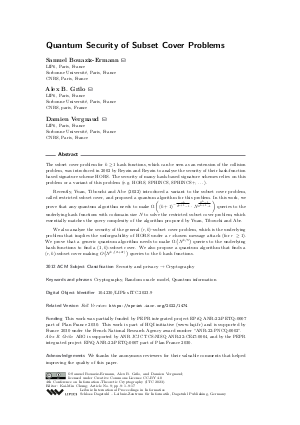@InProceedings{bouazizermann_et_al:LIPIcs.ITC.2023.9,
author = {Bouaziz-Ermann, Samuel and Grilo, Alex B. and Vergnaud, Damien},
title = {{Quantum Security of Subset Cover Problems}},
booktitle = {4th Conference on Information-Theoretic Cryptography (ITC 2023)},
pages = {9:1--9:17},
series = {Leibniz International Proceedings in Informatics (LIPIcs)},
ISBN = {978-3-95977-271-6},
ISSN = {1868-8969},
year = {2023},
volume = {267},
editor = {Chung, Kai-Min},
publisher = {Schloss Dagstuhl -- Leibniz-Zentrum f{\"u}r Informatik},
address = {Dagstuhl, Germany},
URL = {https://drops-dev.dagstuhl.de/entities/document/10.4230/LIPIcs.ITC.2023.9},
URN = {urn:nbn:de:0030-drops-183378},
doi = {10.4230/LIPIcs.ITC.2023.9},
annote = {Keywords: Cryptography, Random oracle model, Quantum information}
}

 Creative Commons Attribution 4.0 International license
Creative Commons Attribution 4.0 International license

